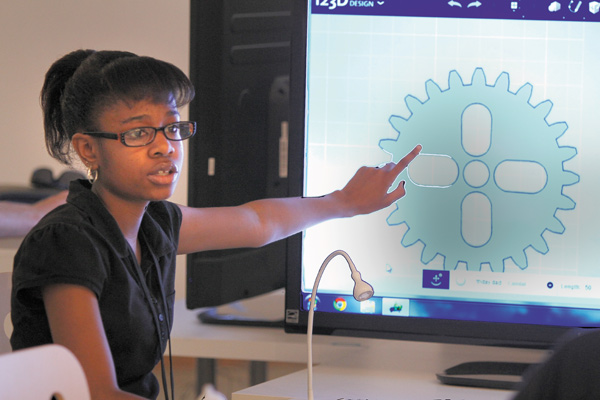

Wednesday, July 17, 2013

Next year, Youngstown schools will be one of, if not the only school district in the country with the type of technology and program offered through the Discovery Learning Program. Janahy Robinson, 17, a student in the Chaney Science, Technology, Engineering and Mathematics program, works on her project, using equipment at the McDonough Museum of Art, similar to what will be at the Discovery program at Kirkmere school next year.
By Denise Dick
Youngstown
Next school year, the city schools will be one of, if not the only, school district in the country with the type of tech- nology and programs offered through the Discovery Learning Program.
The program for third- through eighth-graders at the former Kirkmere Elementary School will include 3-D printers, holographic screens and work stations that not only foster team and cooperative learning but also demonstrate the real-world applicability of what they learn.
“Kids have a natural inclination to want to be creative,” said Jack Scott, founder and president of Applied Systems & Technology Transfer (AST2).
The Youngstown company is providing the equipment and personnel to work with teachers and students in the lab. The district’s cost is about $88,000 with about half of it a one-time expenditure. The money is coming from federal dollars, not the school district’s general fund.
Scott said traditional education teaches children’s natural creativity out of them.
He gave an example of walking into a kindergarten classroom and asking the students how many of them consider themselves artists. Every hand would likely go up. Asking a class of fourth-graders the same question, however, would elicit far fewer raised hands, Scott said.
At the Kirkmere lab, dubbed Innovation Creation Space, students would come up with a design and use the 3-D printer to create it.
Students need to be taught that their ideas have value. It’s not all about a teacher’s lecture or what’s in a book, Scott said.
School has to a lot of competition for students’ attention and oftentimes, the competition is more fun.
Equipment in the lab allows learning to be more appealing to students.
The equipment could be used in science class to allow students to create 3-D models of a human heart. The complexity of the model would depend on the ages of the students involved.
“Youngstown is the only one to have this,” Scott said. “I don’t know of any other school in the country that has anything comparable to what’s going into Kirkmere.”
Doug Hiscox, city schools deputy superintendent for academic affairs, said the district is always looking for ways to build a stronger foundation for students going into other programs such as the Science, Technology, Engineering and Mathematics courses.
“We were also looking to create something that isn’t anywhere else,” he said. “This will be the first one in the country.”
Besides providing a foundation for engineering, the lab will be used across the curriculum for all grades, Hiscox said.
“Kids will be exposed to it on a pretty regular basis,” he said.
AST2 also developed the INVENTORcloud program used by high school students across Ohio, including a lab at Choffin Career and Technical Center.
Julie Michael Smith, executive vice president of AST2, sits on the Business Advisory Council for the school district and when she and Scott learned of Superintendent Connie Hathorn’s plans to create the Discovery Program at Kirkmere, they approached him about a similar program for younger students.
Scott said the program will build students team skills and teach them to collaborate with one another.
Joe Jeswald, a retired Girard City Schools educator, has been working with the district to develop the program to fit with the district curriculum.
One module teaches about the Mahoning River, detailing its history, its importance during the steel-industry boom and more recent efforts to clean it up. In another, elements of science and social studies will be taught as students learn about the early uses of engineering.
“There’s always been engineering, even before they called it engineering,” Jeswald said.